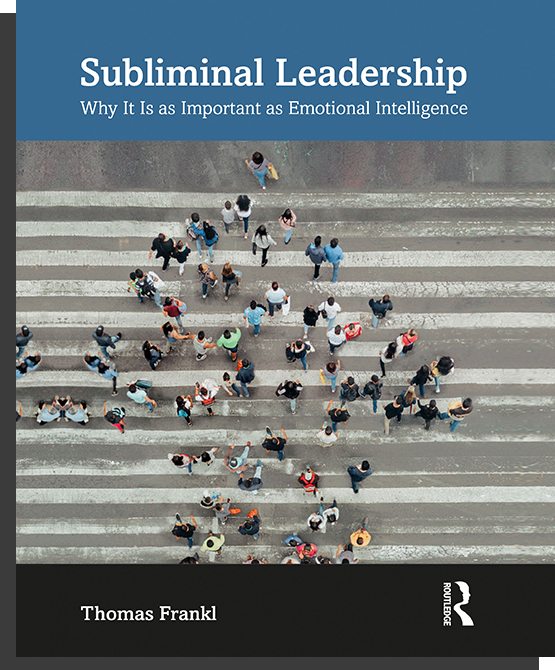
Leadership
Subliminal
THOMAS FRANKL


The Book
It happens below the threshold of our conscious awareness: subliminal forms of body language and communication which influence other people’s attitudes, thinking and behaviour – and which may boost, or undermine a leader’s authority, the performance of teams or the quality of key customer relationships.
Subliminal Leadership
IN STORE
Online bookshops across Europe and the United States

The Book
It happens below the threshold of our conscious awareness: subliminal forms of body language and communication which influence other people’s attitudes, thinking and behaviour – and which may boost, or undermine a leader’s authority, the performance of teams or the quality of key customer relationships.
Subliminal Leadership
IN STORE
Online bookshops across Europe and the United States
Subliminal leaders are more effective leaders. They know the answers to the following five key leadership questions:
1.
Why are some leaders trusted and even loved while others need to resort to ‘sticks and carrots’ to get things done?
2.
What is it that turns some people into leaders and others into followers?
3.
What subliminally motivates people to give their best, as opposed to what’s in their job description and what are the subliminal factors in ‘quiet quitting’?
4.
How do you build an outstanding team? (Spoiler: it’s not by putting the best people in a team).
5.
‘Gut feelings are as valid as hard data in decision-making’ (Tim Cook, CEO of Apple): How can leaders improve the score of their intuitive decisions?

Subliminal leadership builds on subliminal influence
The answer lies in the power of subliminal influence. Effective leaders are aware of their subliminal influence, and, in turn, of being subject to subliminal influence. The book explains in a clear and accessible way this important, yet little known and understood, area of psychology and leadership.
As Emotional Intelligence helped managers and leaders to understand the importance of empathy in the workplace, Subliminal Leadership takes us to the next level by explaining how influence through non-verbal communication mostly happens below the threshold of our conscious awareness: subliminal forms of body language and communication which influence other people’s attitudes, thinking and behaviour – and which may boost, or undermine, a leader’s authority, the performance of teams or the quality of key customer relationships.

Subliminal leadership builds on subliminal influence
The answer lies in the power of subliminal influence. Effective leaders are aware of their subliminal influence, and, in turn, of being subject to subliminal influence. The book explains in a clear and accessible way this important, yet little known and understood, area of psychology and leadership.
As Emotional Intelligence helped managers and leaders to understand the importance of empathy in the workplace, Subliminal Leadership takes us to the next level by explaining how influence through non-verbal communication mostly happens below the threshold of our conscious awareness: subliminal forms of body language and communication which influence other people’s attitudes, thinking and behaviour – and which may boost, or undermine, a leader’s authority, the performance of teams or the quality of key customer relationships.
Leading Negotiations
Will you get a fair deal or will you get shortchanged? In negotiations, the outcome depends on your ability to sense what the people in a room feel, in contrast to what they might communicate through words or body language. Lies and deceit, unless in specific contexts such as contracts, don’t count as criminal offences and hence they are omnipresent in business. Even people with perfect self-control involuntarily and subliminally give away brief nonverbal signals revealing their true states of mind. ‘Microexpressions’, lasting between 0.5 and two seconds, expose true feelings and emotions but we typically ignore them among the ‘noise’ of verbal and nonverbal messages. Discovering deceit without the deceiver realizing is a unique skill that can be learned and perfected – and it gives you the all-important edge in negotiations.

Leading Negotiations
Will you get a fair deal or will you get shortchanged? In negotiations, the outcome depends on your ability to sense what the people in a room feel, in contrast to what they might communicate through words or body language. Lies and deceit, unless in specific contexts such as contracts, don’t count as criminal offences and hence they are omnipresent in business. Even people with perfect self-control involuntarily and subliminally give away brief nonverbal signals revealing their true states of mind. ‘Microexpressions’, lasting between 0.5 and two seconds, expose true feelings and emotions but we typically ignore them among the ‘noise’ of verbal and nonverbal messages. Discovering deceit without the deceiver realizing is a unique skill that can be learned and perfected – and it gives you the all-important edge in negotiations.


What’s in it for You?
Readers of this book will learn how we unconsciously communicate and how we positively or negatively influence other people in the process. Understanding subliminal influence will help people in, or aspiring towards, leadership positions to build trust, understand others’ emotions, make better decisions and strengthen professional relationships. Based on recent scientific research in disciplines as diverse as psychology, evolutionary biology, anthropology, medicine, neuroscience and management studies, the book offers a breakthrough, multidisciplinary approach to influence and leadership.

What’s in it for You?
Readers of this book will learn how we unconsciously communicate and how we positively or negatively influence other people in the process. Understanding subliminal influence will help people in, or aspiring towards, leadership positions to build trust, understand others’ emotions, make better decisions and strengthen professional relationships. Based on recent scientific research in disciplines as diverse as psychology, evolutionary biology, anthropology, medicine, neuroscience and management studies, the book offers a breakthrough, multidisciplinary approach to influence and leadership.
About The Author
Thomas Frankl

About The Author

Training
Topics In The Book
Trust
Why are some leaders trusted and even loved while others need to resort to ‘sticks and carrots’ to get things done? How does trust happen, how can it be conjured up in a matter of seconds and if lost, how can leaders win it back and move on?
Leader Emergence
What is it that turns people into leaders and others into followers? What is happening at the subliminal level when people ‘decide’ to follow rather than to lead? What can leaders do to boost their charismatic appeal?
Motivation
Since Maslow’s pyramid of needs, as many theories have emerged as there are forces that motivate behavior. It is time to look at the subliminal forces driving goal-oriented behavior, and self-leadership. People who are great at leading themselves are also great at leading others.
Team Building
It’s all about the outcome, and performance rarely happens in solitary confinement. So how do you build an outstanding team? Put the best people in a team, stupid. Only that it rarely works that way. Teambuilding has an all-important subliminal dimension which must be understood so as to put the right people in one team.
Intuition
It’s all about the outcome, and performance rarely happens in solitary confinement. So how do you build an outstanding team? Put the best people in a team, stupid. Only that it rarely works that way. Teambuilding has an all-important subliminal dimension which must be understood so as to put the right people in one team.
Leading Change
Leadership is about making change happen, whether at an organizational or at an individual level. But before changing the habits, unwritten rules or routines of companies or of employees leaders may need to change as few habits of their own. Self-leadership comes before leadership and knowing how to grow and realize one’s leadership potential is paramount.
Topics In The Book
Trust
Why are some leaders trusted and even loved while others need to resort to ‘sticks and carrots’ to get things done? How does trust happen, how can it be conjured up in a matter of seconds and if lost, how can leaders win it back and move on?
Leader Emergence
What is it that turns people into leaders and others into followers? What is happening at the subliminal level when people ‘decide’ to follow rather than to lead? What can leaders do to boost their charismatic appeal?
Motivation
Since Maslow’s pyramid of needs, as many theories have emerged as there are forces that motivate behavior. It is time to look at the subliminal forces driving goal-oriented behavior, and self-leadership. People who are great at leading themselves are also great at leading others.
Team Building
It’s all about the outcome, and performance rarely happens in solitary confinement. So how do you build an outstanding team? Put the best people in a team, stupid. Only that it rarely works that way. Teambuilding has an all-important subliminal dimension which must be understood so as to put the right people in one team.
Intuition
It’s all about the outcome, and performance rarely happens in solitary confinement. So how do you build an outstanding team? Put the best people in a team, stupid. Only that it rarely works that way. Teambuilding has an all-important subliminal dimension which must be understood so as to put the right people in one team.
Leading Change
Leadership is about making change happen, whether at an organizational or at an individual level. But before changing the habits, unwritten rules or routines of companies or of employees leaders may need to change as few habits of their own. Self-leadership comes before leadership and knowing how to grow and realize one’s leadership potential is paramount.

Subliminal Leadership:
Workshop Modules
Understanding the force of subliminal influence helps answer this and other key questions leaders often wonder about:
Why are some leaders trusted and even loved while others need to resort to coercion to get things done?
What subliminally motivates people to give their best, as opposed to what’s in their job description
What is it that turns some people into leaders and others into followers?
Why are teams composed of the best people rarely the best-performing teams?
What are the subliminal factors underlying powerful communication?
How can I build profound, lasting relationships and prevent people from ‘quietly quitting’?

Subliminal Leadership:
Workshop Modules
Understanding the force of subliminal influence helps answer this and other key questions leaders often wonder about:
Why are some leaders trusted and even loved while others need to resort to coercion to get things done?
What subliminally motivates people to give their best, as opposed to what’s in their job description
What is it that turns some people into leaders and others into followers?
Why are teams composed of the best people rarely the best-performing teams?
What are the subliminal factors underlying powerful communication?
How can I build profound, lasting relationships and prevent people from ‘quietly quitting’?
The below modules can be combined as needed, or constitute one
workshop of between three and five days

Emotional Contagion
Emotions are not only experienced in the brain. Emotions are ‘embodied’ and transmit from leaders to followers through olfactory, auditory, and visual signals.
In exercises, participants will explore both the astonishing acuity of human senses and how their state of emotions affects their colleagues through the transmission of olfactory, auditory or visual signals.

The Subliminal Power of Humor
Humor fosters mutual trust and candor and supports a spirit of team cooperation and creativity. A humorous remark at the appropriate time can contribute to an atmosphere of psychological safety, an environment in which employees generally thrive. While spontaneous humor cannot be trained in a seminar, participants will recognize the physiological processes underlying humor, laughter, and smiling – and when they would be advised to refrain from using humor.

Creating a Fearless Organisation
Fear, the strongest human emotion, can be paralyzing. It prevents employees from speaking up, from taking risks and from challenging the status quo. Fear is the greatest enemy of creativity and innovation.
How can leaders create a ‘fearless organization’? What can they do to create an environment of trust and high performance and what are subliminal reasons for a loss of trust in leadership? How can lost trust be regained? Analyzing trust-based corporate cultures and leadership, participants will practice the skill of building trust and confidence.

Reading the Room
Empathy, an emotional response to specific stimuli, is central to the concept of Emotional Intelligence. The more profound, subliminal dimension of empathy, however, has only recently been uncovered. One example is the ability to ‘read a room’ – a complex leadership skill with our highly developed sensory capacities at its core. The skill to read a room is developed in this training.
Another example is the ability to quickly ‘size up’ other people; both ‘reading a room’ and ‘sizing up’ other people are key ingredients of successful negotiation and mediation. They border on mind-reading, or ‘Theory of Mind’ as cognitive psychologists like to refer to it. Who wouldn’t want to be better at understanding how others really think and feel?

Communicating with Impact
What made both ‘I have a dream’ unforgettable, but also the infamous ‘sinking platform’ metaphor? How can ‘boring’ corporate data or financials, and their presenter, ever leave a lasting impression? What makes communication effective and how can a leader communicate with lasting impact? The answer lies in a scientifically established method to balance data and emotions effectively. Participants will analyze video speeches and improve their communicative effectiveness in practical exercises.

Raising your Charismatic Profile
Charisma is a powerful leadership attribute, but few leaders appear to possess it.
What is charisma and what makes leaders to be perceived as charismatic?
Who and what establishes who is charismatic?
Is charisma innate or can it be acquired? Participants will observe, analyze and discuss charismatic traits, explore the overt and the subliminal facets of charisma and apply techniques to raise their charismatic profile.

Intuitive Leadership
This session gets to the subliminal bottom of intuitive decision-making and leadership. Successful ‘data-driven’ leaders such as Apple CEO Tim Cook, perhaps counter-intuitively for some, avoid taking important decisions without involving their intuitive mind. How can a leader improve the accuracy of intuitive decisions?
Participants will learn about the physiological basis for our gut feelings, how we can boost our intuitive skills and at the same time, live more healthily.

Connecting Brains
Team performance results to a large extent from the degree of inter-connectedness of the brains of its members. What might sound esoteric has been substantiated over the past few years by a wide range of neurobiological and physiological research. Participants will learn how to facilitate inter-brain connectivity between people and achieve outstanding results from otherwise average-performing teams. Assisted by advanced biofeedback devices, participants will explore and apply methods and tools to foster brain connectivity in teams.

Toxic Leadership
They are the biggest contemporary challenge to governance, leadership and sustained organizational performance: toxic leaders. What are the distinguishing features of toxic leaders? What subliminally attracts followers to toxic leaders? Why do they rise in non-toxic organizations to levels where they are allowed to spawn toxic a culture? Given that highly intelligent toxic job candidates are masters of dissimulation, what can organizations do to avoid hiring them in the first place? Psychiatrists and neurologists have only recently made astonishing discoveries giving HR departments for the first time effective tools to prevent toxic leaders from infecting organizations.

Self-Leadership
Before leading others, leaders need to work on their self-leadership competence. Learning from masters of self-leadership workshop participants will learn techniques how to keep one’s physiological response to stress under control and to keep a cool head.
If leaders manage to keep their mind on the work, followers will too. With the assistance of sophisticated neurofeedback technology, participants will learn to increase concentration, maintain focus and better manage distractions.
The below modules can be combined as needed, or constitute one
workshop of between three and five days

Emotional Contagion
Emotions are not only experienced in the brain. Emotions are ‘embodied’ and transmit from leaders to followers through olfactory, auditory, and visual signals.
In exercises, participants will explore both the astonishing acuity of human senses and how their state of emotions affects their colleagues through the transmission of olfactory, auditory or visual signals.

The Subliminal Power of Humor
Humor fosters mutual trust and candor and supports a spirit of team cooperation and creativity. A humorous remark at the appropriate time can contribute to an atmosphere of psychological safety, an environment in which employees generally thrive. While spontaneous humor cannot be trained in a seminar, participants will recognize the physiological processes underlying humor, laughter, and smiling – and when they would be advised to refrain from using humor.

Creating a Fearless Organisation
Fear, the strongest human emotion, can be paralyzing. It prevents employees from speaking up, from taking risks and from challenging the status quo. Fear is the greatest enemy of creativity and innovation.
How can leaders create a ‘fearless organization’? What can they do to create an environment of trust and high performance and what are subliminal reasons for a loss of trust in leadership? How can lost trust be regained? Analyzing trust-based corporate cultures and leadership, participants will practice the skill of building trust and confidence.

Reading the Room
Empathy, an emotional response to specific stimuli, is central to the concept of Emotional Intelligence. The more profound, subliminal dimension of empathy, however, has only recently been uncovered. One example is the ability to ‘read a room’ – a complex leadership skill with our highly developed sensory capacities at its core. The skill to read a room is developed in this training.
Another example is the ability to quickly ‘size up’ other people; both ‘reading a room’ and ‘sizing up’ other people are key ingredients of successful negotiation and mediation. They border on mind-reading, or ‘Theory of Mind’ as cognitive psychologists like to refer to it. Who wouldn’t want to be better at understanding how others really think and feel?

Communicating with Impact
What made both ‘I have a dream’ unforgettable, but also the infamous ‘sinking platform’ metaphor? How can ‘boring’ corporate data or financials, and their presenter, ever leave a lasting impression? What makes communication effective and how can a leader communicate with lasting impact? The answer lies in a scientifically established method to balance data and emotions effectively. Participants will analyze video speeches and improve their communicative effectiveness in practical exercises.

Raising your Charismatic Profile
Charisma is a powerful leadership attribute, but few leaders appear to possess it.
What is charisma and what makes leaders to be perceived as charismatic?
Who and what establishes who is charismatic?
Is charisma innate or can it be acquired? Participants will observe, analyze and discuss charismatic traits, explore the overt and the subliminal facets of charisma and apply techniques to raise their charismatic profile.

Intuitive Leadership
This session gets to the subliminal bottom of intuitive decision-making and leadership. Successful ‘data-driven’ leaders such as Apple CEO Tim Cook, perhaps counter-intuitively for some, avoid taking important decisions without involving their intuitive mind. How can a leader improve the accuracy of intuitive decisions?
Participants will learn about the physiological basis for our gut feelings, how we can boost our intuitive skills and at the same time, live more healthily.

Connecting Brains
Team performance results to a large extent from the degree of inter-connectedness of the brains of its members. What might sound esoteric has been substantiated over the past few years by a wide range of neurobiological and physiological research. Participants will learn how to facilitate inter-brain connectivity between people and achieve outstanding results from otherwise average-performing teams. Assisted by advanced biofeedback devices, participants will explore and apply methods and tools to foster brain connectivity in teams.

Toxic Leadership
They are the biggest contemporary challenge to governance, leadership and sustained organizational performance: toxic leaders. What are the distinguishing features of toxic leaders? What subliminally attracts followers to toxic leaders? Why do they rise in non-toxic organizations to levels where they are allowed to spawn toxic a culture? Given that highly intelligent toxic job candidates are masters of dissimulation, what can organizations do to avoid hiring them in the first place? Psychiatrists and neurologists have only recently made astonishing discoveries giving HR departments for the first time effective tools to prevent toxic leaders from infecting organizations.

Self-Leadership
Before leading others, leaders need to work on their self-leadership competence. Learning from masters of self-leadership workshop participants will learn techniques how to keep one’s physiological response to stress under control and to keep a cool head.
If leaders manage to keep their mind on the work, followers will too. With the assistance of sophisticated neurofeedback technology, participants will learn to increase concentration, maintain focus and better manage distractions.
Thomas Frankl
Latest Articles
Resilience. What leaders can learn from the world’s top athletes
The Evolutionary Biology of Leadership
The Chemistry of Leadership
The Physics of Leadership
Thomas Frankl
Latest Articles
Resilience. What leaders can learn from the world’s top athletes
The Evolutionary Biology of Leadership
The Chemistry of Leadership
The Physics of Leadership
SEND ME A MESSAGE
CONTACT INFORMATION

+41 22 366666-1

tfrankl99@gmail.com

Les Bossons Audry 1273 Arzier-Le Muids Switzerland
Do you have questions about how we can help your company? Send us an email and we’ll get in touch shortly.
SEND ME A MESSAGE
CONTACT INFORMATION

+41 22 366666-1

tfrankl99@gmail.com

Les Bossons Audry 1273 Arzier-Le Muids Switzerland
Do you have questions about how we can help your company? Send us an email and we’ll get in touch shortly.
Interested in updates, recommended literature and
the latest research ?
You can unsubscribe anytime !
Interested in updates, recommended literature and
the latest research ?
You can unsubscribe anytime !
Have Questions?
Get in touch!

Phone: +41 22 366666-1

Email: tfrankl99@gmail.com

SEND ME A MESSAGE
CONTACT INFORMATION

+41 22 366666-1

tfrankl99@gmail.com

Les Bossons Audry 1273 Arzier-Le Muids Switzerland
Do you have questions about how we can help your company? Send us an email and we’ll get in touch shortly.
Have Questions?
Get in touch!

Phone: +41 22 366666-1

Email: tfrankl99@gmail.com

SEND ME A MESSAGE
CONTACT INFORMATION

+41 22 366666-1

tfrankl99@gmail.com

Les Bossons Audry 1273 Arzier-Le Muids Switzerland
Do you have questions about how we can help your company? Send us an email and we’ll get in touch shortly.

